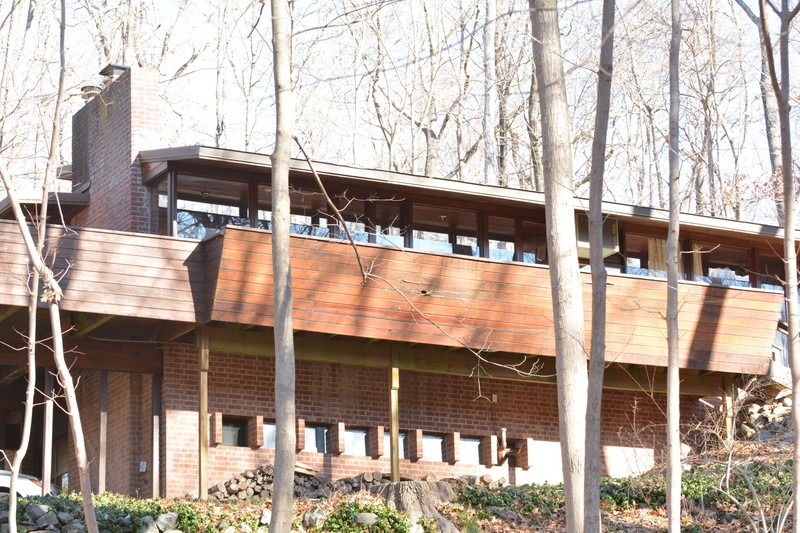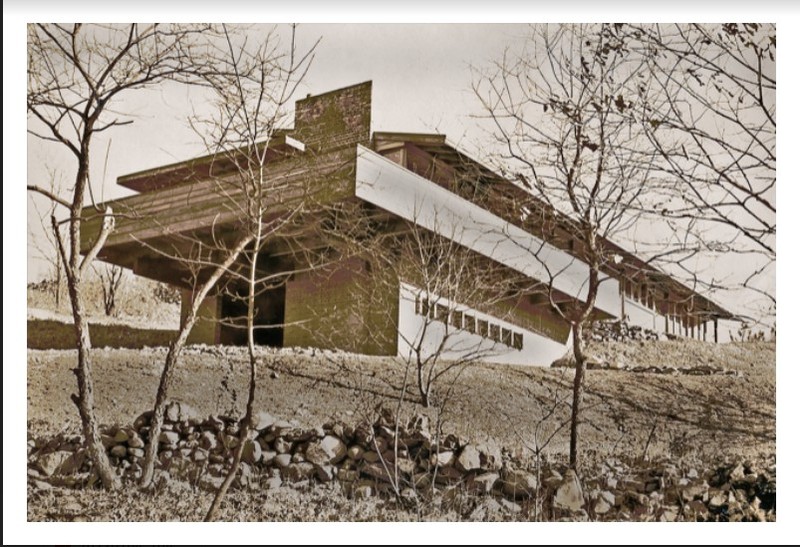Watts House (Usonia Historic District)
Introduction
Text-to-speech Audio
The Watts House is one of two homes in the Usonia Historic District in Pleasantville, NY, designed by architects Paul Schweikher and Winston Elting, partners in the firm Schweiker & Elting, Architects, from 1945-1953. The other Usonia home designed by the duo is the Lew House. Completed in 1949, the Watts House possesses many of the quintessential Usonian design features found elsewhere in the community, including concrete slab, horizontal cypress siding, and a massive brick chimney. The one-story, long rectilinear residence is built into a hillside, exposing its lower-level garage, and allowing for a large, wrap-around porch. Originally cantilevered, it is presently supported by iron poles. Stairs on the north elevation provide access from the driveway to the main level. The Usonia Historic District, which includes the Watts House, was placed on the National Register of Historic Places in 2012.
Images
Watts House

Watts House

Watts House

Backstory and Context
Text-to-speech Audio
Paul Schweikher (1903-1997), originally from Colorado, studied engineering, art, and architecture at various institutions, including The Art Institute of Chicago and the Yale School of Architecture, where he graduated from in 1929. During the 1930s and 40s, he collaborated with a number of successful architects, especially in the Chicago area. In recognition of his talent and originality, some of his models and drawings were included in an exhibition at the Museum of Modern Art in 1933. Schweikher partnered with architect Winston Elting in the firm of Schweikher & Elting, Architects, from 1945-1953, after which time he served as head of the Carnegie Mellon School of Architecture.
Winston Elting (1907-1968) was formally trained at Princeton University in New Jersey and the Ecoles des Beaux Arts in Paris. He began his career working within the Housing Division of the Public Works Administration before going into private practice. During his partnership with Schweikher, the pair co-designed two Usonia homes in Pleasantville, NY. Some of Elting’s other works include the chapel, theater, and Fine Arts Center at Maryville College in Tennessee, the Language Center at Vassar College, and the Unitarian Church in Evanston, Illinois. For much of the 1960s, Elting taught architecture at the University of Illinois, Chicago.
Sources
- “Robert Paul Schweikher.” USModernist. https://usmodernist.org/schweikher.htm. Accessed Oct 20, 2021.
- "Schweikher and Elting, Architects (March 20-April 14, 1949)." The Renaissance Society at The University of Chicago. http://archive.renaissancesociety.org/site/Exhibitions/Biography.Schweikher-and-Elting-Architects.509.html. Accessed Nov 17, 2021.
- "Schweikher House." https://www.schweikherhouse.org/paul-schweikher/. Accessed Oct 23, 2021.
- “Usonia Historic District #12000600.” National Register of Historic Places. United States Department of the Interior/National Park Service. Sept 5, 2012. https://catalog.archives.gov/id/75323279
- Fortin, Cassandra. “The Mid-century Modern house that sits at…” Special to the Chicago Tribune. July 18 1999. https://www.chicagotribune.com/news/ct-xpm-1999-07-18-9907180350-story.html. Accessed Oct 23, 2021.
- Reisley, Roland. Usonia, New York: Building a Community with Frank Lloyd Wright. Princeton Architectural Press. 2003.
- Ro, Laura. “Midcentury home in Frank Lloyd Wright’s Usonia community asks $1.6M.” Curbed. June 15, 2018. https://archive.curbed.com/2018/6/15/17467566/paul-schweikher-winston-elting-usonia-pleasantville-ny. Accessed Oct 19, 2021.
Roland Reisley
Will Jhun for WCHS
Roland Reisley
